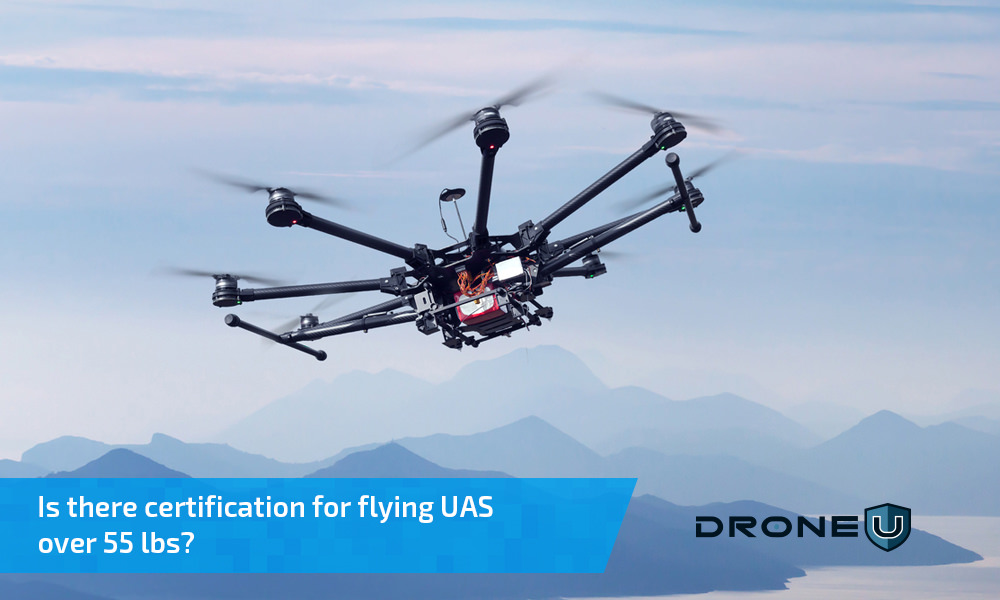In this blog post, you will learn how to fly large drones over 55 pounds using a section 333 exemption. Furthermore, we also compare FAA 333 exemption to Part 107. Which is the best option for commercial drone pilots? And why? Read on to find out.
Can You Fly a UAS over 55 pounds under Part 107?
It is a known fact that commercial drone pilots need a Part 107 certification to comply with the law of the land. However, when it comes to extremely small drones (weighing less than 250 grams [.55 pounds]) and really large drones (weighing more than 55 pounds), drone certification requirements are quite different.
For drones weighing less than 250 grams, commercial drone pilots do not need any certification at all. In fact, according to the industry rumors, the eagerly awaited DJI Spark 2 might fall in this category.
However, when it comes to large drones weighing more than 55 pounds, things are not so simple. Large drones are used for applications like crop spraying, drone deliveries, and LiDAR. The world’s largest drone, the Feihong-98 tips the scale at a large 5.25 tons.
According to the latest drone rules, anyone wanting to fly a UAS over 55 pounds will have to seek exemption under Special Authority for Certain Unmanned Systems (49 U.S.C. §44807). Section 44807 of the 2018 FAA Reauthorization Act replaces FAA 333 exemption of the FAA Modernization and Reform Act of 2012.
So, Can I No Longer Fly Under Part 333 Exemption?
No. Section 333 is not dead.
You can still fly your drone under a Section 333 exemption. According to the FAA website, a total of 5551 exemptions have been granted to date.
How do I File for a Section 44807 (Previously Section 333) Exemption?
Section 44807 of the 2018 FAA Reauthorization Act states that:
“Notwithstanding any other requirement of this chapter, the Secretary of Transportation shall use a risk-based approach to determine if certain unmanned aircraft systems may operate safely in the national airspace system”.
So, how does the FAA plan on implementing this risk-based approach to ensure the safety of the national airspace system?
These are some essential pointers for filing your Section 44807 Exemption:
- Describe the design and operational characteristics for the type(s) of UAS in as much detail as possible
- Training of PIC and flight experience matters a lot
- Describe your plan for ensuring safety
- Specify the proposed maximum operating speed and altitude, minimum flight visibility and distance from clouds
- You will need to obtain a COA too. The FAA issues a Blanket COA to everyone with a Section 44807 exemption. If you wish to operate outside the purview of a blanket COA, you can also apply for a full COA. To learn more about the different kinds of COA’s and how they compare to Part 107, check out our show, “Should public safety offices get a Part 107 or a COA?”
You can also check out FAA’s document, “How to File a Section 333 Exemption” for more details on this. Once you have reviewed this document, you can file your petition on the public docket.
Section 333 Exemption vs. Part 107 – Comparison
No doubt, getting your Part 107 certification is a far easier option. Let us first discuss the advantages of getting your Part 107 certification over a Section 333 exemption.
- Requirements for getting a Section 44807 exemption are far more stringent
For starters, only Part 61 manned aircraft license holders can apply for a Section 44807 exemption. Compared to this, there are no such requirements for getting your Part 107 license. Anyone who is above the age of 16, can speak good English and is in sound mental and physical condition can apply for a Part 107 license.
- You can get your Part 107 in just 15 days
Drone registration requirements for Section 333 exemption holders mandate that they must use the traditional Part 47 process. Part 47 is a cumbersome and paper-based process that takes much longer than Part 107.
While the entire Part 107 certification process can take as little as 15 days, getting your Section 44807 exemption can take as long as 120 days.
- Medical Requirements are far more relaxed for Part 107 aspirants
If you are applying for a Section 333 exemption, you MUST furnish a medical certificate
- Section 333 exemption holders must use Visual Observers at all times
Section 333 exemption holders must use a visual observer at all times. Using a VO is not mandatory for Part 107 license holders.
Section 333 Exemption vs. Part 107 – What are the Similarities?
- Both are valid for two years
- You are always required to maintain Visual Line of Sight
- You need permission to fly in controlled airspace
- You cannot fly higher than 400 feet AGL
You can check out all the requirements in this FAA’s application for a Blanket COA
Conclusion
Getting a Part 107 license is undoubtedly the better option if you are flying one of the popular consumer drones like the Phantom or Mavic. However, if you wish to fly a large UAS over 55 pounds, applying for a Section 333 exemption is your ONLY resort.
Become a Drone U Member.
Do not forget to subscribe and listen to Ask Drone U, the #1 drone podcast on iTunes!






Add Your Comment